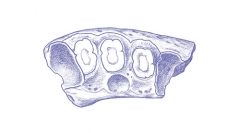

 Comptes Rendus Palevol
23 (7) - Pages 95-105
Comptes Rendus Palevol
23 (7) - Pages 95-105Large isolated skeletal elements, including those of sphenacodontid and ophiacodontid synapsids from the upland cave systems of the Richards Spur locality, Oklahoma, are described. Multiple forms of visual representation, including coquille and stipple drawings, are used to document and examine the isolated elements. A fragmentary anterior portion of a dentary has the sphenacodontid four-leaf clover plicidentine attachment within the tooth roots, but the teeth are all of uniform size, and the symphyseal area is relatively slender and does not curve upward, suggesting that the specimen may not belong to any known member of the clade. A larger humerus with only the distal end preserved and a complete astragalus have distinct characteristics which are attributable to the sphenacodontid Dimetrodon Cope, 1878. A second, smaller humerus was identified to belong to Ophiacodon Marsh, 1878, cf. O. navajovicus and represents the first record of an ophiacodontid at Richards Spur. Finally, two large sphenacodontid interclavicles were discovered, with one having unusual growths representing a pathological condition. Typically, large amniotes are quite rare in this early Permian upland ecosystem, but the discovery of the new material shows that large synapsids are present at Richards Spur.
Amniotes, large synapsids, early Permian, cave deposit, coquille drawing, stipple drawing, pathology